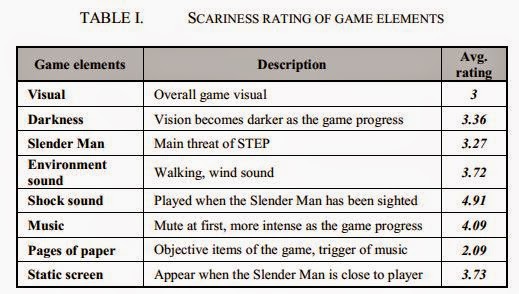Experiment 01:
An analysis of affective state transitions in survival horror game with the aid of player self-reports and physiological signals - Review
Vanus Vachiratamporn, Paul Inventado, Roberto Legaspi, Koichi Moriyama, Masayuki Numao
The Institute of Scientific and Industrial Research, Osaka University
https://kaigi.org/jsai/webprogram/2013/pdf/987.pdf
It is a very interesting read and has given some insight to a new prospect of survival horror games. Using the player's affective state to decipher what happens in a game would be extremely useful for a horror game. This article has provided me with some useful quotes and reference points.
These two games have showed that, by including some randomness into the main horror approach of the games, it can extend the replayability of the game and can create an endless amount of memorable horror scene to any players.- Referencing the games; 'Slender: The Eight Pages' and SCP: Containment Breach
Common emotions that have been mentioned across horror fiction, movies and games are anxiety, suspense and fear [Falsafi 11, Perron 04, Prieto-Pablos 98]. Although some research considers anxiety and suspense as part of a fear experience [Garner 11], these three emotions can be distinguished by the concreteness of how a threat is perceived. Fear is an emotional response to a specific threat or an attempt to cope with threatening events that have already been seen [Öhman 07]. On the other hand, anxiety and suspense occur due to the uncertainty of an upcoming dangerous situation. Anxiety is usually caused by the uncertainty towards an enigmatic or unspecific threat [Falsafi 11, Öhman 07], while suspense is usually caused by the uncertainty of an expected outcome from a threat confrontation [Prieto-Pablos 98]. Fear and anxiety are considered to be different emotions while suspense overlaps between the other emotions [Toprac 11].- Description of anxiety, suspense and fear - common emotions in horror games/films
 |
| Result Table - Rating system = 1 to 5 - 5 being Very scary |
This result also supports the study of Perron [Perron 04] that showed many successful examples of forewarning techniques used in horror movies and horror games, suggesting that long anticipation of a harmful confrontation (suspense) is more disturbing than short anticipation (surprise).- A useful horror technique that can be applied to my game
Experiment 02:
Please Biofeed the Zombies: Enhancing the Gameplay and
Display of a Horror Game Using Biofeedback - Review
Andrew Dekker & Erik Champion
http://www.cs.tufts.edu/~jacob/250pbi/Please_biofeed_the_zombies.pdf
This was a similar report but instead of using the players affective state to alter the gameplay, it was looking into using it to enhance the gameplay - via 'dynamic changes in the game shaders, screen shake, and the creation of new spawning points for the game's non-playing characters'.
This was another interesting read - not much was useful directly too my project but it is fascinating to see what research is out there and imagine what games could potentially be like in the future.
Personal Notes
It might be worth looking into the 'study of Perron' as this shows the techniques of horror movies and games which will definately apply to my project.
No comments:
Post a Comment